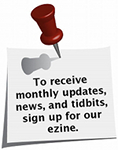Spring Cleaning your Organization’s Website: Getting Back to the Basics
While most organizations are savvy enough these days to provide the information their readers need on their website, the problem is in the ability of that reader to quickly and easily find that information. I’m not talking about finding the organization’s website on the internet, search engine optimization (SEO), or the use of social media; we’ll leave that for another day. I’m talking about the simple navigation, layout, and usability of a website that someone has already found and is using to gather information.
A person’s first view into an organization is quite frequently their first view of that organization’s website. If the website is cluttered, disorganized, or inefficient, the viewer (or potential donor) will likely think the same is true of the organization and move on to some other recipient. Also, if a website is shiny, flashy, and well groomed but has little or no useful information, the organization will appear to have no substance or purpose.
Take a moment to think about your organization. Look away from your computer and think of its top one or two priorities. Write them down. Now, think of its next (secondary) priorities and write them down. Finally, think about whom each of these priorities is intended to serve. In other words, who are your organization’s audiences? Write them down. Now open your organization’s website and consider the following:
- Does the first page of your website welcome your intended audiences? Think about who you are targeting with your website. Is it potential donors? Current and/or potential clients? Employees and volunteers? Service users? Does the first page of your website have an area for each of these readers to quickly find the information they need? This information may overlap or be completely separate. Does your website make these distinctions (or lack there of) clear?
- Does the first page of your website clearly show your organization’s top priorities? Review your list. Are your priorities highlighted on your main page? Don’t get into too much detail - you can go into that as you funnel down into your site.
- Do you funnel the information for your audience clearly? Less is more. Do not clutter your site, spitting out everything on the main page. You’ve given the overview; now give more detail as you drill down. Introduction pages on your site should not be much more than one computer screen long. People don’t want to scroll down to find information. Once you get into the meat of a subject, only then should you lengthen your pages.
- Does your site provide a clear call to action? Once the reader gets into the information, what do they do with it? Do you engage them to interact with a service, experience, or resource? Can they donate? Register to volunteer? Sign up for services? What meaningful action can they take right there on the spot?
- While doing all of the above, do you allow for people with different styles of thinking and browsing? Left brain/right brain - different people have different styles of maneuvering through a website. Don’t go overboard, but give people options. Perhaps you have visuals? Make those visuals into links to topic areas. However, if one topic area has a visual link, all of them should have a visual link. Meanwhile, keep that navigation bar on the top or on the side of your pages.
- Is it easy for your readers to contact you from each and every page on your site? Think of the phrase “out of sight, out of mind”. If your reader wants to contact you about something of interest, they may forget why by the time they make it to a contact page. Don’t get me wrong – contact pages are important and you need them. However, provide a phone number or email address on all of your pages.
- Do you routinely and consistently review and update the information on your website? As a nonprofit, you are in the business of helping someone or something, or providing a service. This is a perfect opportunity to create new information your readers will want to return to again and again. What is that information that will engage your readers?
Bottom Line: Just like your home, your website needs an occasional review and refresher to fit with your organization’s direction and the direction of the modern user. Take a look at your site as if it was the first time you’ve seen it. Role play as different audience types when you visit your site. Does it still work for you? If not, it may be time to make some changes.
Jenny Kearney maintains the Capability Company website and communications. She also develops clean and simple websites for small business owners. You can see her work at www.jskearney.com.


